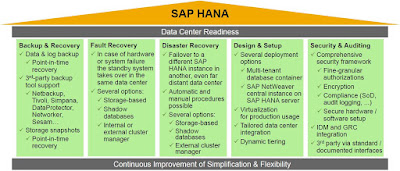My purpose is to deep-dive into the entire SAP HANA high availability (HA), fault recovery (FR) and disaster recovery (DR) concept including the high-level overview of ALL available HA, FR and DR options, different configuration and setup methods and key benefits and trade-offs of each technology. I aim to provide deeper, clear and broader information in SAP HANA HA and DR technologies unlike the majority of confusing and contradictory information available on the internet. At the end of the day, you will be able to compare all available DR, FR and HA options, learn how to ensure your system’s operational continuity and decide the most suitable approach for your own data center readiness scenario to meet the business requirements.
This very first article is an introduction to the series and will mostly cover to the areas I am going to explain. Herewith some of the current SAP HANA capabilities from data center readiness point of view:
This very first article is an introduction to the series and will mostly cover to the areas I am going to explain. Herewith some of the current SAP HANA capabilities from data center readiness point of view:
Before we start, we need to understand what our KPIs are when it comes to HA and DR from business continuity planning perspective, so we can make better-informed decisions. There are two main objectives:
Recovery Point Objective (RPO): Maximum tolerable period of time which operational data is lost without the ability to recover. This is your business continuity plan’s maximum allowable threshold for data loss. The RPO is expressed backwards in time (that is, into the past) from the point the failure occurs.
Recovery Time Objective (RTO): Maximum permissible time it takes to recover the system after a disaster (or disruption) for system operations to resume. This objective can include the time for trying to fix the problem without recovery options, the recovery itself and testing of services before handing over to the business users.
These two KPIs help system architects choose optimal high availability and disaster recovery technologies and procedures in SAP HANA platform.
Our target RPO for business-critical systems should be ZERO DATA LOSS and minimum possible RTO in all production environments. And the key requirement to achieve these is to apply the most effective data replication method in both HA and DR scenarios.
Agenda starting from the second article:
- Single Points of Failure
- High Availability Options
- Fault Recovery Support
- Disaster Recovery Support
- Service Auto-Restart
- Host Auto-Failover (with scale-out scenario, heartbeat and fencing capabilities)
- Storage Replication (remote networked storage, both
- System Replication (Covering all replication modes AND both operation modes in detail)
- Backup and Recovery (filesystem, 3rd party backup tools, snapshots)
- Near-Zero Downtime Maintenance
- Comparison
If you liked this post, you might like these relevant posts:


No comments:
Post a Comment